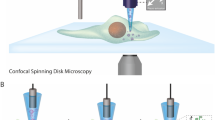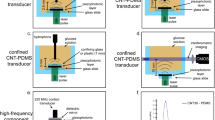Abstract
A galinstan expansion femtosyringe enables femtoliter to attoliter samples to be introduced into prokaryotes and subcellular compartments of eukaryotes. The method uses heat-induced expansion of galinstan (a liquid metal alloy of gallium, indium, and tin) within a glass syringe to expel samples through a tip diameter of about 0.1 μm. The narrow tip inflicts less damage than conventional capillaries, and the heat-induced expansion of the galinstan allows fine control over the rate of injection. We demonstrate injection of Lucifer Yellow and Lucifer Yellow–dextran conjugates into cyanobacteria, and into nuclei and chloroplasts of higher organisms. Injection of a plasmid containing the bla gene into the cyanobacterium Phormidium laminosum resulted in transformed ampicillin-resistant cultures. Green fluorescent protein was expressed in attached leaves of tobacco and Vicia faba following injection of DNA cantaining its gene into individual chloroplasts.
This is a preview of subscription content, access via your institution
Access options
Subscribe to this journal
Receive 12 print issues and online access
$209.00 per year
only $17.42 per issue
Buy this article
- Purchase on Springer Link
- Instant access to full article PDF
Prices may be subject to local taxes which are calculated during checkout




Similar content being viewed by others
References
Kempers, R. & van Bel, A.J.E. Symplasmic connections between sieve element and companion cell in the stem phloem of Vicia faba L. have a molecular exclusion limit of at least 10 kDa. Planta 201, 195–201 (1997).
Kamei, Y. et al. A CBP integrator complex mediates transcriptional activation and AP-1 inhibition by nuclear receptors. Cell 85, 403– 414 (1996).
Oka, M.T. Arai, T. & Hamaguchi, Y. Microinjection of the monoclonal anti-tubulin antibody YL1/2 inhibits cleavage of sand dollar eggs. Cell Struct. Func. 15, 373–378 ( 1990).
Höner, B., Citi, S., Kendrick-Jones, J. & Jockusch, B.M. Modulation of cellular morphology and locomotory activity by antibodies against myosin. J. Cell. Biol. 107, 2181– 2189 (1998).
Rose, D.W., McCabe, G., Fermisco, J.R. & Adler, M. Expression of c-fos and AP-1 activity in senescent human fibroblasts is not sufficient for DNA synthesis. J. Cell. Biol. 119, 1405–1411 (1992).
Staiger, C.J. et al. Microinjected profilin affects cytoplasmic streaming in plant cells by rapidly depolymerizing actin microfilaments. Curr. Biol. 4, 215–219 (1994).
Walton, P.A., Gould, S.J., Rachubinski, R.A., Subramani, S. & Feramisco J.R. Transport of microinjected alcohol oxidase from Pichia pastoris into vesicles in mammalian cells: involvement of the peroxisomal targeting signal. J. Cell. Biol. 118, 499–508 (1992).
Kost, B., Galli, A., Potrykus, I. & Neuhaus, G. High efficiency transient and stable transformation by optimized DNA microinjection into Nicotiana tabacum protoplasts. J. Exp. Bot. 46, 1157–1167 (1995).
Nguyen, L., Lucas, W.J., Ding, B. & Zaitlin, M. Viral RNA trafficking is inhibited in replicase-mediated resistant transgenic tobacco plants. Proc. Natl. Acad. Sci. USA 93, 12643– 12647 (1996).
Heinzel, T. et al. A complex containing N-CoR, mSin3 and histone deacetylase mediates transcriptional repression. Nature 387, 43–48 (1997).
Van der Schoot, C. Determinants of xylem-to-phloem transfer in tomato. Thesis, Univ. Utrecht (1989).
Knoblauch, M. & van Bel, A.J.E. Sieve tubes in action. Plant Cell 10, 35–50 ( 1998).
Hibberd, J.M., Linley, P.J., Khan, M.S. & Gray, J.C. Transient expression of green fluorescent protein in various plastid types following microprojectile bombardment. Plant J. 16, 627– 632 (1998).
Golds, T., Maliga, P. & Koop, H.U. Stable plastid transformation in PEG-treated protoplasts of Nicotiana tabacum. Bio/Technology 11, 95–97 (1993).
Haseloff, J., Siemering, K.R., Prasher, D.C. & Hodge, S. Removal of a cryptic intron and subcellular localization of green fluorescent protein are required to mark transgenic Arabidopsis plants brightly. Proc. Natl. Acad. Sci. USA 94, 2122– 2127 (1997).
Grebenok, R.J. et al. Green-fluorescent protein fusions for efficient characterisation of nuclear targeting. Plant J. 11, 573– 586 (1997).
Köhler, R.H., Hansen, M.R. & Wildman, S.G. Plastid interconnections imaged by fluorescence and phase contrast. Trends Cell. Biol. 7, 392 (1997).
Köhler, R.H., Cao, J., Zipfel, W.R., Webb, W.W. & Hanson, M.R. Exchange of protein molecules through connections between higher plant plastids. Science 276, 2039–2042 (1997).
Svab, Z. & Maliga, P. High frequency plastid transformation in tobacco by selection for a chimeric aadA gene. Proc. Natl. Acad. Sci. USA 90, 913–917 (1993).
Khan, M.S. & Maliga, P. Fluorescent antibiotic resistance marker for facile identification of transplastomic clones. Nat. Biotechnol. 17, (1999).
Maliga, P. Towards plastid transformation in flowering plants. Trends Biotechnol . 11, 101–107 ( 1993).
Takeshima, Y., Duguira, M. & Hagiwara, H. A novel expression vector for the cyanobacterium Synechococcus PCC 6301. DNA Res. 1, 181–189 (1996).
Daniell. H. et al. Transient foreign gene expression in chloroplasts of cultured tobacco cells after biolistic delivery of chloroplast vectors. Proc. Natl. Acad. Sci. USA 87, 88–92 (1993).
Daniell, H., Krishnan, M. & McFadden, BF. Transient expression of beta-glucuronidase in different cellular compartments following biolistic delivery of foreign DNA into wheat leaves and calli. Plant Cell Rep. 9, 615 –619 (1991).
Rippka, R., Waterbury, D.J., Herdman, M. & Stanier, R.Y. Generic assignments, strain histories and properties of pure cultures of cyanobacteria. J. Gen. Microbiol. 111, 1– 61 (1979).
Handler, J.S., Perkins, F.M. & Johnson, J.P. Hormone effects on transport in cultured epithelia with high electrical resistance. Am. J. Physiol. 240 , 103–105 (1981).
Acknowledgements
We extend our thanks to Dr. Hubert Felle (University of Giessen, Germany), Dr. Winfried Peters (University of Frankfurt, Germany), and Dr. Walter Schröder (Nuclear Research Centre, Juelich, Germany), for helpful technical discussions, Dr. Ursula Richter (University of Giessen, Germany) and the ZBB (University of Giessen) for scanning electron microscope imaging of the pipette tips, Dr. Wolfgang Clauβ (University of Giessen) for Xenopus distal kidney tubule A6 cell cultures, and the Geraberger Thermometer Werke GmbH for a supply of galinstan for the first tests. We also thank Dr. Chris Howe (Department of Biochemistry, University of Cambridge, UK) for supplying P. laminosum. We thank the EU for Grant BIO4 CT972245 as part of the Plasmonet consortium for funding.
Author information
Authors and Affiliations
Corresponding author
Rights and permissions
About this article
Cite this article
Knoblauch, M., Hibberd, J., Gray, J. et al. A galinstan expansion femtosyringe for microinjection of eukaryotic organelles and prokaryotes. Nat Biotechnol 17, 906–909 (1999). https://doi.org/10.1038/12902
Received:
Accepted:
Issue Date:
DOI: https://doi.org/10.1038/12902
This article is cited by
-
Generation, analysis, and transformation of macro-chloroplast Potato (Solanum tuberosum) lines for chloroplast biotechnology
Scientific Reports (2020)
-
Local tissue manipulation via a force- and pressure-controlled AFM micropipette for analysis of cellular processes
Scientific Reports (2018)
-
Can liquid metal flow in microchannels made of its own oxide skin?
Microfluidics and Nanofluidics (2016)
-
The myth of interconnected plastids and related phenomena
Protoplasma (2015)
-
Divide and shape: an endosymbiont in action
Planta (2013)



